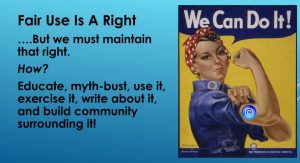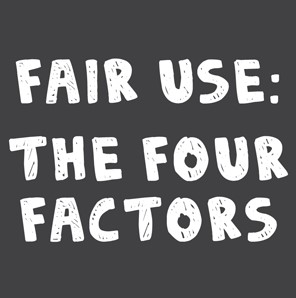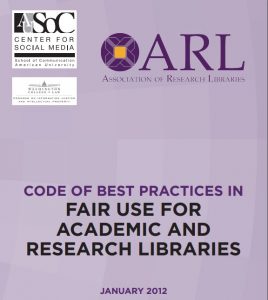Fair Use and Exigent Circumstances
*The opinions and scholarship communicated on this website are the author’s own, expressed in his personal capacity.*
If you work in any of the higher ed institutions that are preparing to move online – maybe your copyright world has exploded in a range of questions on fair use, e-reserves, online access, scanning, digitization, and more! I am sure many of you, especially in the library community, are working towards the best solution for students, faculty, staff, and patrons in this time of crisis.
To help you navigate this process, over the next few posts (working as I go) I will offer reminders of all the super awesome legal tools libraries have for copyright as “stewards of access” in our communities.
As I have often messaged, libraries and archives have “superpowers” under the copyright law that allows us to supply our communities with access to materials for research, scholarship, and study. Most notably, these statutory exemptions were granted to libraries and archives by Congress to ensure our continued public mission. Further, libraries can utilize technology to enhance access to materials. Adapting and utilizing technology for the benefit of our patrons is something that libraries and archives have been successful at for decades – from the first photocopiers in libraries, microfiche, computer labs, to 3-D printers!
So, in times like this COVID-19 crisis, let’s continue to harness both law and technology to help!
Before I get to the TEACH Act, Section 108, or any other superpower – first and foremost, we must talk about fair use. While this isn’t a library superpower – fair use is for everyone! – it certainly falls to the libraries and archives, in many circumstances, to be the champions of fair use on campus (and bust any fair use myths!)

In questions I’ve received, tweets I’ve been following, and posts to the Copyright First Responders lists about libraries’ responses to COVID-19, what is pervasive is the sense that this isn’t a normal “par for the course” moment. These are exigent circumstances with a limited timeline, and we, as libraries, have a strong mission and public purpose. In response to the COVID-19 public health crisis and ensuing campus closures, we can make use of the “release valve” that fair use offers. We have a lot of space to support our communities in this moment as long as we’re being thoughtful, providing good copyright information when asked, and limiting our activities to the specific, time-bound needs of instructors and students for the rest of the semester. In doing so, we are applying fair use prudently and managing risk sensibly. We are not crafting permanent policy.
Fortunately, copyright law does not always restrict uses. In many cases a solid understanding of fair use can help ease fears, provide legal alternatives to a particular request, or help educate the higher education community at large.
Again, as long as we’re being thoughtful, providing good copyright information when asked, and limiting our activities to the specific, time-bound needs of our communities for the rest of this timeline, we are in a good place to have a strong fair use analysis.
Yes, we are still applying fair use prudently and managing risk sensibly, but we can do that and clearly meet our user’s needs!
Just to be clear: Fair use is a flexible limitation on copyright which states “Notwithstanding the provisions of sections 106” (the copyright owner’s rights) “the fair use of a copyrighted work…for purposes such as criticism, comment, news reporting, teaching, scholarship, or research” is not an infringement of copyright. And then we are given the famous four-factor test to make that risk determination.
Again, let me emphasize “flexible!” Fair use is flexible and, as the Supreme Court stated in Campbell v. Acuff-Rose Music, Inc., 510 U.S. 569 (1994) “permits and requires courts to avoid rigid application of the copyright statute.” So, if fair use is found, it is, according to the Copyright Act, “not an infringement of copyright.”
The mechanics underpinning fair use were codified in the Copyright Act with the famous four factors: 1) the purpose and character of the use, 2) the nature of the work copied, 3) the amount and substantiality of the work used, and 4) the effect on the market for the original. One has to examine all four factors for each individual use to make a fair use determination.
For the purposes of this blog post, let’s explore a fictional request to scan some materials for a class that is forced to move to online as a result of a COVID-19 closure. Below we will make our way through each of the four factors with an eye to ask some questions and gain an understanding of making a fair use determination for this sort of scenario.

Fair Use Factor One – Purpose and Character: The first fair use factor, “purpose and character of the use,” is illustrated by the examples that is part of the fair use statute preamble: criticism, comment, news reporting, teaching, scholarship or research. Clearly our colleagues working at non-profit educational institutions have a good start for a fair use determination right away. Our use is clearly for the benefit of research and education!
Additionally, let’s put this first factor in the context of the COVID-19 closure scenario. Well, this particular “purpose” is allowing faculty and students to access the materials they need in a public emergency where they are facing quarantines, social distancing, or campus/library closures. This is strong evidence, I believe, for favoring fair use in the “purpose and character” factor.
Fair Use Factor Two – Nature of Copyrighted Work:
When determining whether our COVID-19-related scanning request is a fair use under the second factor, we must ask ourselves a couple of questions about the work at hand: Is it published or unpublished; and how “creative” is the original work?
While the law is more protective of unpublished work, because authors have right to decide whether and when they will make their work public, courts have largely ignored this factor, with some calling it “neutral” in many recent decisions. Certainly, many higher ed courses use both factual works and creative works.
Certainly do not see this factor as dispositive of the entire fair use test – let’s move forward to the next factor!
Fair Use Factor Three – Amount and Substantiality Used: The third factor receives major discussion in both court cases and scholarship surrounding fair use. A common question that examines this factor derives directly from the critical facts in most fair use cases: How much is being used? If it’s a smaller amount of a copyrighted work, it favors fair use. But what about a request for an entire work?
Well, despite any myths you may have heard, it can be fair to use an entire work. However, it must be a justified fair use. The important thing to remember is that the law favors using the right amount necessary to serve the users purpose. There are no bright lines when it comes to what percentage of the copyrighted work is too much and typically, the higher the percentage, the more likely this factor is to count against fair use.
However, let’s apply this to a new common COVID-19 scenario: The use of a book when the campus moves online. Maybe we consider that we do not scan the whole textbook, unless it is absolutely necessary. And it may be absolutely necessary! And it also may not be! The factor is assessed based on the facts of the scenario.
For example, a class may have already covered Chapters 1-7 for the first part of the semester – and now, moving online, they need chapters 8, 9, 10, and 11 to finished out the semester. The library may have used fair use analysis to tailored this request to the needs of the faculty and students. This action is employing part of the fair use rationale that states that one should use only the amount necessary to serve the purpose.
The syllabus certainly helps with calculating the need and amount used. I have observed recommendations making materials available to students that are measured by the class syllabus from the “move online” moment to the end of the semester. Now, that might be more than any library policy “rules of thumb” that normally exist. But again, this is not the normal policy – and wouldn’t be representative of the factual scenarios we are being presented with now with the COVD-19 crisis. Fair use decisions are rendered case-by-case, thankfully, and we can look to amount needed as necessary to serve the purpose.
Now, here’s another novel issue. What if the student needs access to the book for studying for the final test? Chapters 1-7, which were previously only available on reserve (or left behind in the abandoned dorm room) are now inaccessible. Can we expand the digitization request beyond chapters 8, 9, 10, and 11 to finished out the semester ? Again, we have to look at the limited use, timing, and exigent circumstances of this scenario. Use the same standard as always used under factor three: the use should use only copy the amount necessary to serve the purpose
Fair Use Factor Four – Market Effect: This is another factor that gets a lot of discussion both in the fair use court cases and commentary. The question often revolves around whether the proposed use will cut into the potential market or value of the work. And we have seen court cases stating that using a copyrighted work in a way that means lost sales to the copyright owner will weigh against fair use.
This last factor gets a lot of discussion both in fair use court cases and commentary. The question often revolves around whether the proposed use will cut into the potential market or value of the work.And court cases have stated that using a copyrighted work in a way that means lost sales to the copyright owner will weigh against fair use. In considering market effect, the law tries to protect creators.
Again, our current example is based on limited usage in a time of crisis. Some folks have discussed doing a “market check” to see whether there is a digital market available. We need to remember, however, an e-book, which is “purchased” subject to a license, is not really owned the same way a physical counterpart would be. E-books and other electronic media may restrict the very uses that would serve our patrons in this circumstance, leaving us to make a well-reasoned fair use.
However, again, what we may have here is based on the limited usage in a time of crisis. Some folks have discussed doing a “market check.” Explore if there is a digital market available. But remember, an e-book, which is “purchased” subject to a license, isn’t really owned in the same sense because of the license. And, in fact, e-books, and other e-media, may restrict the uses that would serve the patrons in this exigent circumstance.
And there may be absolutely no market for this type of emergency use. Not everything has a market!

Add Up The Factors:
Adding up the factors is not an exact science. In fact, with four factors to balance, there frequently may be a “tie.” Fair use is not a rigid formula that leads to clear-cut answers telling users when it’s okay to use work without permission. Instead, fair use is meant to be a flexible approach that weighs all the results of four-factor balancing test together. And here, as we have discussed, an excellent fair use
There are other factors to consider when evaluating a fair use. Some of these questions can lead a user to smart risk-based decisions. For example, attribution or citation are critical components of good scholarly work. And although the words “attribution” or “citation” do not appear in the fair use statute, they are certainly influential factors when making a fair use analysis. Proper attribution lets the reader know that this is not the original copyrighted material; it is created by a 3rd party, but it is being used fairly. By providing the proper citation, authors can avoid accusations of plagiarism and contribute to a beneficial fair use analysis.
Knowing and applying fair use analysis correctly also gives you another positive factor that is not mentioned in the statue: a reasonable belief, formed in good faith, that the use qualifies as fair. The courts have stated that the “propriety of the defendant’s conduct” may be “relevant to the ‘character’ of the use’.” While this won’t necessarily shift the balance of a fair use analysis, it may influence a 3rd party or other entity that could question a person’s fair use. And, should a person get into real legal trouble, a party looks much better in the courtroom if they have “clean hands,” meaning that they are good faith users of content. It may even affect the outcome of the case in the damages phase of the trial.

Fair Use Best Practices in Action!
Over the last decade, library codes of best practices have become common tools used by the community to mitigate risk for a host of civil and criminal wrongs, including fair use and copyright infringement. The term “best practices“ has not been defined by case, statute, or regulation very well, and it has its origins in business management, not law. That said, there are some elements of them found in the law; the Uniform Commercial Code, for example, is an attempt to codify industry best practice.
These library best practices are usually compiled from the practices and values of a particular community’s mission. While they are not law, they have the effect of defining what is “reasonable,” so that if litigation does arise the courts can look to the best practices either as a form of a good faith effort or to alleviate some of the brunt of liability. Determining the minimum practices necessary to protect against potential liability will ultimately be decided on a case-by-case basis in a court of law.
These codes of best practice are an excellent tool of education and risk mitigation, however, and serve as indicators of what is reasonable for a particular profession or work function. And I think there relevance is even more important now!
The Code of Best Practices for Fair Use in Academic and Research Libraries by Association of Research Libraries, the Center for Social Media, School of Communication, American University, and the Program on Information Justice and Intellectual Property, Washington College of Law, American University was devised specifically by and for the academic and research library community. It bolsters the ability of librarians to rely on fair use by documenting the considered views of their community about best practices in fair use, drawn from the actual experience of the library community itself (http://www.centerforsocialmedia.org/libraries).
I’d point out that Section One in the Code is “Supporting Teaching and Learning With Access To Library Materials via Digital Technologies.” The first Principle listed states: “It is fair use to make appropriately tailored course-related content available to enrolled students via digital networks” with a great discussion and consideration.
Lowering Fair Use Risk: Library Innocent Infringer § 504(c)(2)
Lastly, my discussion of fair use for libraries and archives ends on a positive risk mitigating note!
If a library is found guilty infringing a copyrighted work, there is a potential chance that there will be no statutory damages for such infringement. Congress, again, offers libraries and archives one last chance to avoid penalty in section § 504(c)(2). This section states that if the infringer is a library or archive, or the employee of a library or archive, then the court can lower or eliminate damages altogether if the infringer “believed and had reasonable grounds for believing that his or her use of the copyrighted work was a fair use under § 107.”
I’d like to say we all believe! And, more critically, by learning, using, and applying fair use in good faith – we are getting protection from the severe damages under § 504(c)(2)!
[To help support this in practice, maybe consider trying and retaining any documentation that determined that the alleged use was a fair use. Knowledge of this section can also aid the “total” analysis for risk-mitigation of various library activities.]
Well… that’s part I for now. Part II, Section 108 and the TEACH Act are available on LLRX here.
Editor’s Note: This Two Part article is republished with the author’s permission, with first publication on his blog.
